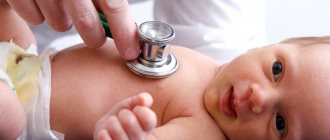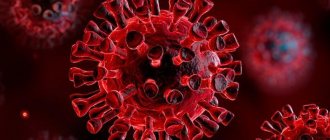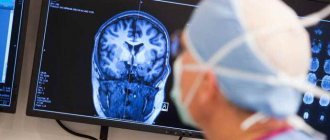The movements of a newly born baby are considered uncoordinated. Therefore, they may resemble newborn seizures. A similar phenomenon is often not confirmed, and for those who are diagnosed with this, thorough treatment is required. This disease is associated with several disorders. One of the reasons may be a difficult pregnancy.
Why do newborns experience hypoglycemic seizures?
Hypoglycemic seizures in infants are caused by a decrease in blood glucose: in full-term infants - below 2 mmol/l (less than 35 mg/100 ml), in premature infants - below 1.4 mmol/l (25 mg/100 ml). A repeated decrease in glucose below 2.6 mmol/l is potentially dangerous for the newborn.
Transient hypoglycemia of newborns is caused by the pathology of pregnancy (preeclampsia, placental circulation disorders, multiple pregnancies), fetal distress, perinatal hypoxia, diseases of newborns - HFRT, infectious-toxic diseases, sepsis, meningitis, RDS, iatrogenic causes - administration of large quantities to pregnant and parturient women. glucose, the use of tocolytics - β-agonists, sudden cessation of parenteral administration of hypertonic glucose solutions to a newborn, replacement blood transfusion in the treatment of tension-type headache, late breastfeeding.
Another reason why a newborn experiences hypoglycemic convulsions may be the mother's treatment with anti-diabetic sulfonamides.
Causes of persistent hypoglycemia: intrauterine hypotrophy, Beckwitt-Wiedemann syndrome, hereditary metabolic diseases (leucinosis, galactosemia, mitochondrial diseases, glycogenosis type I, fructose intolerance), adrenogenital syndrome and hemorrhages in the adrenal glands, tension-type headache, diabetes mellitus in the mother.
The following clinical forms of neonatal hypoglycemia are distinguished: transient neonatal hypoglycemia - with diabetic fetopathy, prematurity, intrauterine growth retardation, hypothermia; persistent neonatal hypoglycemia occurs with hyperinsulinism (nisidioblastosis, Wiedemann-Beckwith syndrome, islet cell adenoma of Langerhans), hypofunction of the pituitary gland, adrenal glands, thyroid gland, glucagon deficiency, and with hereditary disorders of carbohydrate, fat and amino acid metabolism.
The danger of hypoglycemia lies in a generalized disruption of metabolic processes due to energy deficiency, which can lead to neurological disorders. Hypoglycemia is extremely dangerous in the early neonatal period for premature babies also because, by causing a compensatory increase in cerebral blood flow, it can contribute to the occurrence and progression of intraventricular hemorrhages.
Clinical picture. Beckwitt-Wiedemann syndrome is a genetically determined pathology, a large child syndrome with a large tongue, umbilical hernia and divergence of the rectus abdominis muscles, folded ears, visceromegaly (enlarged liver, kidneys, heart). Due to macroglossia, the child may experience respiratory disorders, difficulty sucking, and hypoglycemia.
Treatment consists of correcting hypoglycemia by intravenous glucose and, in severe cases, insulin antagonists; ensuring adequate nutrition; maintaining temperature comfort, correcting hypothermia.
If hypoglycemia develops, a 10% dextrose solution is prescribed - intravenously, in a stream over 2-4 minutes, 2 ml/kg (200 mg/kg), then intravenously slowly at a rate of 3-5 ml/(kg•h) (6-8 mg/ (kg • min)), until the condition stabilizes and the full volume of feeding is introduced.
If there is no effect (disappearance of hypoglycemia), contrainsular hormones are prescribed within 4-6 hours : hydrocortisone - intravenously 5-10 mg/(kg•day) in 1-3 injections until blood glucose levels normalize or glucagon intramuscularly 0.025 mg/kg ( maximum single dose 1 mg) or prednisolone - intravenously 2-3 mg/(kg•day) in 1-3 injections, until blood glucose levels normalize.
For persistent severe hypoglycemia, the drug of choice is diazoxide (orally 5-15 mg/kg in 3 divided doses until blood glucose levels normalize).
After normalization of glucose levels, hormonal therapy should be discontinued and dextrose administration continued for some time.
Failure in metabolic processes
A small body needs adequate nutrition for growth and strength. Cramps may occur due to a lack of elements such as calcium, vitamin B6, magnesium, and some amino acids. This situation does not mean that the mother is prone to starvation and needs to change her diet. The child may have poor functioning kidneys, thyroid or adrenal glands.
The most common metabolic disorders:
- hypokalemia – calcium is contained in the blood in insufficient quantities;
- hypoglycemia – decreased blood glucose levels;
- hypomagnesemia - magnesium is present in the blood in too low a concentration, but this is rare;
- water intoxication – a condition in which the body’s cells retain water, which significantly reduces the sodium content and leads to an imbalance in the water-salt balance;
- excess sodium also does not bode well and also causes cramps;
- changes in the metabolism of amino acids (proline, tyrosine, glycine, valine, etc.);
- lack of vitamin B6.
Hypoxic-ischemic convulsions in infants: how to recognize and what to do
The most common causes of seizures in newborns are hypoxic-ischemic and traumatic brain lesions; the second most common cause is perinatal, including intrauterine infections.
Clinical picture. With hypoxic-ischemic encephalopathy, it is usually not difficult to recognize seizures in infants: they occur several hours after birth (sometimes several days), are more often focal or multifocal clonic, and are combined with rhythmic nystagmus and apnea. Such spasms in newborns look like flexor spasms.
Involuntary “local” movements are often observed - the equivalent of cramps in an infant, as well as muscle hypotension with general depression. Sometimes muscle tone is increased and the child is excited. There is an increase in the activity of creatine kinase B in the blood plasma, and an increase in the concentration of lactates in the cerebrospinal fluid.
Ultrasound and CT scans of the brain reveal focal areas of reduced density or a diffuse decrease in brain density.
Intracranial hemorrhages are observed in children with low birth weight. With intracranial hemorrhage, generalized or focal convulsions are combined with nystagmus, muscle hypotonia, abnormal pupillary reactions, sometimes opisthotonus or floppy baby syndrome. Cardiovascular and respiratory disorders (neurogenic RDS) are common. To detect hemorrhages, ultrasound of the brain is used as a screening test. CT confirms the diagnosis, nuclear magnetic resonance imaging (NMRI) can identify vascular abnormalities of the brain as a possible basis for hemorrhages. The cerebrospinal fluid is xanthochromic, 1 μl contains from 100 to several thousand red blood cells, the protein content exceeds 200 mg/100 ml, the glucose level is steadily reduced - less than 30 mg/100 ml.
Treatment. Anticonvulsants are used - intravenously and intramuscularly: 0.5-1% solution of seduxen at 0.3-0.5 mg/kg, 0.25% solution of droperidol at 0.3-0.5 mg/kg, 20% solution of hydroxybutyrate sodium 50-100 mg/kg.
What else do doctors do for such cramps in infants? Dehydration therapy is carried out: Lasix is administered intravenously or intramuscularly at 1-3 mg/(kg•day), intravenously 10-20 ml of 20% glucose solution, concentrated plasma (diluted with double-distilled water in a ratio of 2:1), antihemorrhagic agents: Vicasol, aminocaproic acid, vitamin C.
Causes of seizures
Cramps are antispasmodic muscle contractions that can occur in the upper and lower extremities, as well as in the neck and head, and are accompanied by small tremors. As a rule, the causes of seizures are neurological in nature, but often they are also symptoms of more serious diseases that require close attention.
Statistics show that premature babies experience seizures 20 percent more often than babies born at full term. The risk of developing epilepsy in the first four weeks of a child's life is 1-3 percent.
Let's consider the main reasons for the development of convulsive contractions:
- Meningitis, encephalitis;
- Ischemic encephalopathy or stroke account for about 60 percent of cases;
- Epilepsy;
- Metabolic disorder, which is expressed in hypocalcemia or hypoglycemia.
The above reasons are symptoms of seizures in newborns, which occur in 80 percent of cases.
Diagnostics
Not all twitching or shaking of the limbs in newborns are seizures. To classify seizures, it is necessary to undergo an electroencephalograph (EEG) examination. This device allows you to monitor changes in brain activity and determine the nature of convulsive contractions.
There are often cases when doctors initially diagnose epilepsy and prescribe treatment with antiepileptic drugs. But if no improvement is observed and muscle twitching does not go away, then it is worth undergoing a more in-depth examination and considering damage to the cerebral cortex as a preliminary diagnosis.
This may be indicated by accompanying symptoms, such as rapid breathing and loss of consciousness.
Treatment Options
Seizures in newborns are first carefully monitored in the intensive care unit, and then the doctor makes a diagnosis and prescribes appropriate treatment. After all, the main task of the treating doctor in this situation is to correctly identify the cause of the baby’s convulsive condition.
If the convulsions are prolonged, then the basis of treatment is drugs made from barbituric acid or, as they are also called, “barbiturates”. Thanks to them, the central nervous system relaxes, muscle contractions reduce their intensity, and the child’s condition returns to normal.
Depending on the severity of the seizures, short, medium or long-term effects of drugs may be prescribed.
It is worth noting that more successful treatment of convulsive contractions should be comprehensive. Good results are achieved by maintaining a friendly environment in the family, proper nutrition of the baby, gymnastic procedures, relaxing massage and hardening with water procedures.
Over the next few years after successful treatment of seizures, the baby must be observed by a neurologist and undergo annual preventive examinations and examinations.
Now you know what seizures of various types may indicate in newborns from the first days of life.
If this happens to your baby, you should not immediately panic, but, without delay, seek the advice of a doctor so as not to miss the development of serious diseases. Health to you and your children!
What hypocalcemic seizures look like in infants: symptoms and treatment
Hypocalcemia occurs when the total calcium level in the blood plasma decreases below 1.75 mmol/l. It can be early, appearing on the 2nd-3rd days of life, or late - on the 5-14th day of life. The risk of developing early hypocalcemia is especially high in premature infants and children with intrauterine malnutrition, born with asphyxia and with HFRT, as well as in newborns from mothers with diabetes.
Clinical picture. For early hypocalcemia, the most typical are generalized convulsions with episodes of cyanosis, shortness of breath or apnea, a high-pitched cry, and hyperesthesia. Sometimes hypocalcemic seizures in infants appear as small tremors of the chin and fingers, accompanied by laryngospasm. Focal seizures are also possible. Hypocalcemia can be practically asymptomatic or manifest itself in the form of hypotension and apnea attacks.
The causes of late hypocalcemic seizures in a newborn child are hypoparathyroidism and pseudohypoparathyroidism, congenital vitamin D-resistant rickets, acute renal failure, artificial feeding with cow's milk formulas containing a significant amount of phosphates. Also, the cause of hypocalcemic seizures in infants is diarrhea with metabolic acidosis. Congenital aplasia of the parathyroid glands and thymus gland is characteristic of Di George syndrome.
A decrease in the level of ionized calcium in plasma is caused by citrates (during exchange transfusions of blood stabilized by citrates), intralipid administered during parenteral nutrition (increases the level of free fatty acids that bind calcium in the blood). Alkalosis with hyperventilation and kidney disease contributes to the manifestation of hypocalcemia.
With late hypocalcemia, along with convulsions in a newborn child, hyperexcitability, hyperesthesia, tremor, muscle twitching, a high-pitched cry, and tachycardia are more often observed. Possible manifestations include laryngospasm with short-term cessation of breathing, tetany with carpopedal spasm, positive symptoms of Khvostek, Trousseau, Lyust. Oh, inspiratory stridor, vomiting, bloating, gastrointestinal bleeding, tonic convulsions.
The diagnosis can be suggested by clinical findings; confirmation is a decrease in the level of total calcium in the blood serum of less than 2 mmol/l in full-term infants and less than 1.75 mmol/l in premature infants. Hypocalcemia is also confirmed by a prolongation of the QT interval of more than 0.2 seconds (according to ECG results).
Treatment. Early hypocalcemia in the absence of clinical symptoms usually does not require treatment. In the presence of clinical symptoms or a pronounced decrease in calcium concentration, a 10% solution of calcium gluconate is administered intravenously at 0.5-1 ml/kg (no more than 10 ml) at a rate of 1 ml/min under control of heart rate (rapid administration leads to bradycardia). If the dose is ineffective, repeat the administration after 15 minutes.
When treating hypocalcemic seizures in newborns, calcium preparations should not be mixed with sodium bicarbonate solutions. The introduction of calcium solutions into the umbilical artery can cause the development of necrotizing enterocolitis. If it is not possible to relieve increased neuromuscular excitability with calcium preparations, it is advisable to administer intramuscularly a 25% solution of magnesium sulfate at a dose of 0.25 ml/kg.
Seizures in young children
Myoclonic seizures (infantile spasms or West syndrome), generalized and partial seizures.
According to the causes of seizures, they are divided into:
- Tetanic convulsions (spasmophilia)
Develop in the first days of life: 3 days - early hypocalcemia and after the 5th day - late hypocalcemia and are apparently caused by a decrease in the concentration of ionized calcium in the blood due to rickets, dysfunction of the parathyroid glands, intoxication including vitamin D, and dehydration as a result diarrhea and vomiting. The latent period is characterized by the symptoms of Chvostek, Lyust, Trousseau.
Clinic
Attacks of spasm of gaze upward or to the sides, tonic spasms of the limbs, sometimes with the formation of the obstetrician's hand. Following these symptoms, generalized tonic convulsions may develop with loss of consciousness for up to 2 minutes. Convulsions can recur like eclamptic status. With normalization of the ionic composition they stop.
They develop in the first 48 hours of life when sugar levels drop below 1.1 mmol/l. At the beginning of the attack, children turn pale, become covered in sweat, general weakness develops, anxiety appears, and breathing is impaired. Profound hypoglycemia is accompanied by generalized, often tonic, convulsions. Intravenous administration of glucose stops the attack. The pathogenesis is based on hereditary metabolic diseases, galactosemia. Macquarie syndrome, lactic acidosis, hormonal disorders, malnutrition and asphyxia of newborns, low body weight, prematurity.
N.P. Shabalov "Childhood diseases"
Galactosemia: a disorder of carbohydrate metabolism, inherited in an autosomal recessive manner. Described in 1908 by A. Reuss. the nature of metabolic disorders was established by H. Calcar in 1956. The disease is associated with the inability of the body to use galactose and manifests itself in the form of severe damage to the liver, nervous system, eyes and other organs. The frequency is 1:20,000, and the frequency of heterozygous carriage is 1:268.
The disease is based on the absence or sharp decrease in the activity of the enzyme galactose-1-phosphate-uridyltransferase, which is necessary in the second stage of the conversion of galactose into glucose (galactosemia 1, classical). The product of the initial metabolism of galactose, galactose-1-phosphate, which precedes the block, accumulates in the blood of patients, which has a toxic effect on the body. Galactosemia is characterized by true hypoglycemia, which can partly explain the malnutrition and growth retardation of sick children.
PAGE # "" Page: "#" "" Page: 2 N.P. Shabalov "Childhood diseases"
Hypotrophy is a chronic nutritional disorder with a lack of body weight. In Anglo-American literature the term malnutrition is used - insufficient nutrition. The main, most common type of malnutrition is protein-calorie malnutrition. As a rule, such children also have a deficiency of vitamins (hypovitaminosis), and sometimes microelements. According to WHO, in developing countries, 20-30% of children have protein-calorie or other malnutrition.
They develop in severe forms of newborn asphyxia (hypoxic-ischemic encephalopathy). As a result of brain hypoxia, hypercapnia and acidosis, cerebral edema progresses and diffuse dysgemic disorders develop with hemorrhage into the brain substance. All this usually leads to the development of tonic-clonic seizures:
Following the tonic phase, a phase of clonic convulsions appears. The eyeballs become motionless, breathing is held. After the attack, muscle hypotension is observed. The child cries, becomes lethargic, drowsy. Convulsive paroxysm does not exceed 2-3 minutes.
Anoxic spasms occur immediately after a difficult birth. The appearance of so-called “delayed” seizures is possible, which appear after 1-2 months and are caused by a previous infection. In this case, it is necessary to think about the development of the epileptic process in children.
- Convulsions caused by birth trauma.
Caused by traumatic brain injury, as a result of which softening and hemorrhages in the medulla and accompanying liquorodynamic disorders often occur.
They appear in the first 3-8 hours of life. With intraventricular hemorrhages, tonic convulsions predominate, with subarachnoid hemorrhages, clonic ones. With subdural and intracerebral hematomas, generalized clonic and tonic convulsions develop in the first two days.
A possible cause of seizures may be intrauterine (3-17%) or postnatal infection of cytomegalovirus, toxoplasmosis, rubella, listeriosis, herpes. They appear in the first hours of life, often clonic.
Ideopathic neonatal seizure syndrome, which develops between the 3rd and 7th days of life, and is possibly associated with a “transient decrease in zinc levels” in the blood of newborns. Clonic twitching lasts 2-3 minutes and occurs up to 40-48 times a day. (Goldberg et al. 1982).
They develop as a result of a lack of pyridoxine or its coenzyme pyridoxol-5-phosphate in the blood. These seizures can occur in utero or in the first 72 hours of a baby's life. Characterized by generalized muscle twitching, myoclonic contractions in the form of nodding and generalized wincing. Doses of pyridoxine, at least 100 mg per day. leads to relief of the attack.
7. Convulsions caused by hemolytic disease of the newborn.
Caused by progressive metabolic disorders as a result of the toxic effect of indirect bilirubin on the brain.
They occur on days 5-7 of life and often manifest as generalized tonic seizures against the background of jaundice, general lethargy, drowsiness, muscle hypotonia, and suppression of congenital reflexes. Later, generalized convulsions recede into the background, subcortical hyperkinesis appears, and a delay in psychomotor development is detected. When the bilirubin concentration is above 200 µmol/l, the brain is affected (mainly the striopallidal system).
8. Convulsions due to congenital developmental anomalies.
Occurs in 5-16% of cases. These include: holoprosencephaly, micropolygyria, agenesis of the corpus callosum, congenital cystosis. Manifestations in the first hours or minutes after birth. With extensive defects - often tonic, with agenesis of the corpus callosum (with Aicardi) - myoclonic convulsions.
9. Familial neonatal seizures
They are rare types of seizures that develop 2-3 weeks after birth, of a generalized nature, frequency 10-20 times a day. There is no delay in psychomotor development, and the bioelectrical activity of the brain is not changed.
Depending on the type of cramp, there are:
1. Tonic neonatal seizures
They are characterized by a peculiar tension in the muscles of the trunk, limbs, and neck, similar to decerebrate rigidity. During a seizure, the child assumes an extensor position with his head thrown back, arms spread out, hands pronated, and legs stretched out and tense.
As a rule, the respiratory rhythm is disturbed according to the type of inspiratory apnea, this is accompanied by cyanosis and hyperemia of the skin. The duration of the attack is about a minute. EEG shows slow wave activity (during an attack). The level of damage is subcortical-stem.
2.Clonic neonatal seizures.
They are characterized by rhythmic muscle twitching of individual muscle groups with a frequency of 1-3 contractions per second. They have a predominantly cortical origin and are more often observed in full-term newborns. Peak-wave complexes may be recorded on the EEG during an attack.
3. Focal (focal) clonic neonatal seizures.
Typical for newborns with hypoxic-ischemic encephalopathy, accompanied by cerebral infarctions, focal hemorrhages, as well as traumatic brain lesions, arteriovenous malformations, abscesses, tumors and other focal lesions.
They manifest themselves as rhythmic clonic twitching of individual parts of the face, arms, torso, legs in the form of either a separate attack or a series. EEG – foci of epileptic brain damage, most often with the appearance of epileptic activity of the “peak-wave” type. After convulsions, the development of mono- or hemiparesis associated with impaired hemocirculation is possible.
4. Multifocal (multifocal) clonic neonatal seizures.
Associated with diffuse convulsive activity of the cerebral cortex and more often occur with metabolic disorders (hypocalcemia, hypoglycemia, decreased pyridoxine in the blood, diffuse cortical dysplasia - micropolygyria, polycystic disease). Convulsions are characterized by asynchronous clonic contractions of individual muscle groups and are migrating in nature. The EEG shows diffuse slow waves, individual peak-wave complexes.
5. Generalized (bilateral) clonic neonatal seizures.
They most often develop in full-term children with diffuse and focal brain lesions and are clinically characterized by clonic convulsions of the arms and legs with loss of consciousness, respiratory rhythm disturbances, cyanosis, and hypersalivation.
6. Fragmentary neonatal seizures.
Associated with profound morphological changes in the brain of a metabolic or congenital nature, manifested by motor or oculomotor stereotypical phenomena with impaired consciousness, autonomic-visceral dysfunction. During an attack, slow-wave activity and peak-wave complexes are recorded on the EEG.
Among these convulsions, atypical ones are distinguished, which are manifested by “floating movements of the arms,” “pedaling” of the feet, and sucking movements of the lips. Blackouts, apnea, and diffuse cyanosis are possible. EEG shows peak-wave complexes.
7.Ophthalmic (oculomotor) neonatal seizures.
They manifest themselves as stereotypical paroxysms of tonic large-scale nystagmoid twitching of the eyeballs, movements of the eyeballs like the “setting” or “rising sun”. These paroxysms may be accompanied by loss of consciousness, apnea or cyanosis. Loss of consciousness during atypical neonatal seizures occurs for a short period of time in the form of absence seizures and is typical for older children. Epileptic neonatal apnea is polyetiological, but more often among the etiological factors hypoxic-traumatic brain damage, metabolic and toxicometabolic disorders, and less often cerebral hemorrhages and neuroinfections are identified. EEG shows slow wave activity or peak-wave complexes. The prognosis is unfavorable.
8. Myoclonic neonatal seizures.
Rarely observed in newborns, they include: axial convulsions, manifested by lightning-fast flexion of the head and neck in the form of “nods” 1-2 times per second, sometimes less often, combined with autonomic-visceral disorders, mydriasis, myoclonic convulsions of the limbs in the form of rhythmic flexion of the arms and legs 1-2 in 10 seconds. There may be mixed convulsions (head, limbs). They develop as a result of severe organic brain damage of a congenital and hereditary degenerative nature, often being a clinical manifestation of epileptic infant West and Lennox-Gastaut syndromes. The EEG shows synchronized peak-wave complexes (hypsarrhythmia), both during and outside of paroxysm.
Seizures that occur during the first 30 days of life.
1. Glucose 25% solution 2 – 4 ml/kg IV in a stream.
2. Pyridoxine 50 mg IV bolus (preferably under EEG control).
3. Calcium. 10% r – r Ca gluconate IV slowly 1 – 2 ml/kg (no more than 10 ml). Before prescribing, it is advisable to ensure the presence of hypocalcemia and hypomagnesemia).
4. Magnesium. 50% r – r IV slowly 0.1 – 0.2 ml/kg.
5. Phenobarbital 10 – 30 mg/kg IV slowly.
6. Phenytoin 15 – 20 mg/kg IV for 20 minutes (under ECG control).
7. Biotin 5 – 10 mg/day orally. (vitamin H).
How to identify seizures in an infant with hypoparathyroidism?
Hypoparathyroidism is a syndrome that occurs when there is a lack of parathyroid hormone, the hormone of the parathyroid glands. Hypoparathyroidism in newborns develops as a result of organic pathology of the parathyroid glands that arose during the prenatal period of fetal development during the formation of embryopathy; may be transient in nature. When the level of parathyroid hormone decreases, the absorption of calcium in the intestine and the excretion of phosphorus decreases, and the reabsorption of phosphorus in the renal tubules increases. The result is hypocalcemia and hyperphosphatemia.
Neonatal hypoparathyroidism is most often a transient condition accompanied by neonatal tetany, hypocalcemia and hyperphosphatemia.
Clinical picture. It is not difficult to identify such convulsions in an infant - they manifest themselves as tetany with carpopedal spasm, positive symptoms of Khvostek, Trousseau, Lyust. Often there is laryngospasm with short-term cessation of breathing. The activity of the parathyroid hormone in the blood is reduced. Radiographs of tubular bones show double contours of the epiphyses.
Treatment. The tactics for relieving convulsions in an infant are the same as for hypocalcemic convulsions, but to eliminate hypoparathyroidism and relapses of convulsive syndrome, the administration of parathyroid hormone in a dose of 0.1-0.2 ml (2 units) intramuscularly and the administration of vitamin D (100,000 IU) are indicated. Hypoparathyroidism in these cases is eliminated within a few weeks.
Types of seizures
Cramps are involuntary muscle contractions. In a baby, they can be different depending on the reason for which they arise. There are several types of seizures in a newborn.
- Minor spasms are small twitching of the limbs, blinking or trembling of the eyelids or facial muscles. If they continue for a long time, they indicate serious pathologies in the development of the nervous system.
- Tonic neonatal seizures are often characteristic of premature babies. They are expressed in the tension of all muscles, and the baby’s body takes the shape of a bow with his head thrown back. A short-term cessation of breathing is possible during an attack.
- Clonic spasms are rhythmic contractions of one muscle group.
- Myoclonic spasms occur more often in older infants.
In addition, according to the location of muscle contractions, focal convulsions are distinguished, multifocal and generalized, that is, spreading throughout the body. There are also febrile convulsions that appear due to high temperature. If muscle contractions are observed in a baby during sleep, then this is a normal reaction to brain development. If there are no other symptoms of pathology, there is nothing to worry about.
What do cramps look like in babies with meningitis: symptoms with video
Convulsions during meningitis in newborns can be generalized, tonic and clonic.
Clinical picture. Usually, tremor, sometimes hemiparesis, bulging of a large fontanel, unstable fever, decreased reactions to the environment, and stupor are detected. Often, cramps during meningitis in infants are accompanied by a symptom such as vomiting. Crucial for diagnosis is the study of cerebrospinal fluid (Gram staining of smears, determination of glucose, protein, cell counting). Bacteriological examination (culture) of blood, latex agglutination with antibodies against group B and K streptococcus, and E. coli antigen are required.
Treatment is based on parenteral administration of antibiotics, the choice of which is determined by the etiology of meningitis, anticonvulsant and other syndromic therapy.
This video shows the symptoms of seizures in infants with meningitis:
How to recognize seizures in an infant with DiGeorge syndrome?
Persistent congenital hypoparathyroidism manifests itself as Di George syndrome, aplasia of the parathyroid glands and thymus. Neonatal tetany develops against the background of severe combined immune deficiency (sepsis).
Clinical picture. Recognizing such convulsions in an infant is usually not difficult. Di George's syndrome is characterized by paresthesia of the skin of the extremities and face, periodically recurring tremor, carpopedal spasm, and laryngospasm. Symptoms of intoxication, dystrophy and other manifestations of the septic process are noted. The level of calcium in the blood is reduced.
Treatment. Emergency care is aimed at eliminating the convulsive syndrome (Seduxen, GHB, etc.), but treatment continues constantly.
Causes
Usually convulsive reactions appear suddenly, the main reasons for their appearance are as follows:
- Head injuries, tumors, etc.;
- Infection (viral or microbial disease: meningitis, herpes, kernicterus, sepsis, rubella, cytomegalovirus, toxoplasmosis, etc., especially if the nervous system is affected);
- Intoxication with poisons, harmful substances;
- Metabolic disorders that affect the functioning of the nervous system;
- Diseases of the nervous system, inflammatory processes, hypoxia, circulatory disorders, etc.;
- Birth injury;
- Heat;
- Vaccinations;
- Genetic predisposition;
- Epilepsy.
Convulsions in a newborn with pyridoxine deficiency: symptoms and treatment
Pyridoxine deficiency in newborns and young children may be accompanied by seizures caused by congenital deficiency of the enzyme pyridoxalkinase. Due to tissue deficiency of active forms of pyridoxal, the synthesis of neurotransmitters - minobutyric acid, glycine, serotonin - is disrupted, which leads to the development of seizures.
Clinical picture. Symptoms of clonic-tonic seizures in newborns with pyridoxine deficiency are strong muscle spasms for a short time and rhythmic muscle twitching. Such convulsions are not stopped by the administration of anticonvulsants, calcium supplements and disappear after the administration of pyridoxine. The calcium and glucose levels in the blood are normal.
Treatment. Anticonvulsants (seduxen, sodium hydroxybutyrate, etc.). If anticonvulsant therapy is ineffective in the absence of hypoglycemia or hypocalcemia, a solution of pyridoxine should be administered intravenously in a single dose of 5-10 mg (1 ml of 5% solution for injection contains 50 mg of pyridoxine hydrochloride).
Types of seizures
Cramps are involuntary muscle contractions. In a baby, they can be different depending on the reason for which they arise. There are several types of seizures in a newborn.
- Minor spasms are small twitching of the limbs, blinking or trembling of the eyelids or facial muscles. If they continue for a long time, they indicate serious pathologies in the development of the nervous system.
- Tonic neonatal seizures are often characteristic of premature babies. They are expressed in the tension of all muscles, and the baby’s body takes the shape of a bow with his head thrown back. A short-term cessation of breathing is possible during an attack.
- Clonic spasms are rhythmic contractions of one muscle group.
- Myoclonic spasms occur more often in older infants.
In addition, according to the location of muscle contractions, focal convulsions are distinguished, multifocal and generalized, that is, spreading throughout the body. There are also febrile convulsions that appear due to high temperature. If muscle contractions are observed in a baby during sleep, then this is a normal reaction to brain development. If there are no other symptoms of pathology, there is nothing to worry about.
How can you tell if your baby is having seizures due to bilirubinemic encephalopathy?
Bilirubinemic encephalopathy develops with a significant increase in the concentration of free (indirect) bilirubin in the blood of newborns due to hemolysis (HDN due to incompatibility of the blood of mother and fetus by group or Rh factor, congenital hemolytic anemia, deficiency of glucose-6-phosphate dehydrogenase), massive blood transfusions , as well as for hypothyroidism.
Clinical picture. Against the background of prolonged jaundice, clonic or tonic convulsions occur. You can tell that a baby is having convulsions by the large-scale tremor of the limbs, and in severe cases by opisthotonus. Children are agitated or sleepy. The liver is enlarged. The critical threshold for the level of bilirubin in the blood plasma of full-term infants is considered to be 342 µmol/l, for premature infants - 256 µmol/l. If the hourly increase in the concentration of bilirubin in the blood plasma is more than 10 µmol/l in full-term infants and more than 8 µmol/l in premature infants, then a replacement blood transfusion should be started.
Treatment. Intravenous administration of anticonvulsants is indicated: 0.5% seduxen solution (0.3-0.5 mg/kg), 20% sodium hydroxybutyrate solution (50 mg/kg), phenobarbital 5-10 mg/(kg•day). Diuretics are used: Lasix 1-3 mg/(kg• day) intravenously, intramuscularly. Conduct a security clearance.
How do seizures manifest in infants with hereditary metabolic diseases?
Neonatal seizures in newborns can occur with hereditary metabolic diseases. Some hereditary metabolic diseases manifest themselves in the newborn period as a formidable symptom complex of neurodistress syndrome or acute neurological disorder syndrome with the sudden development after a few days of apparent well-being in the child’s health.
Clinical picture. Convulsions, persistent vomiting, respiratory distress, sometimes liver enlargement. Coma develops quickly.
The diagnosis is made using gas chromatography-mass spectrometry methods. The content of lactic acid in the blood serum is increased, ketone bodies are detected in the blood and urine.
Treatment. Anticonvulsants are administered intravenously, intramuscularly: 0.5% solution of seduxen at 0.3-0.5 mg/kg, 20% solution of sodium hydroxybutyrate at 50 mg/kg, diuretics: lasix at 1-3 mg/(kg•day ). Metabolic disorders are corrected and antioxidants are prescribed - ascorbic acid, vitamin E, coenzyme Q10.
What do seizures look like in a baby with leucinosis (with video)
Convulsive syndrome in newborns with leucinosis. Leucnosis is a hereditary disease characterized by impaired metabolism of branched carbon chain amino acids (leucine, isoleucine, valine).
Clinical picture. Convulsions with leucinosis in infants look like constantly recurring muscle spasms. Urine has a peculiar odor, reminiscent of maple syrup or hay. An increase in the level of branched carbon chain amino acids - leucine, valine, isoleucine - is detected in the blood; as well as hypoglycemia, hyperammonemia, metabolic acidosis.
The main symptoms of seizures with leucinosis in infants are shown in this video:
Treatment. Anticonvulsants (seduxen, droperidol, sodium hydroxybutyrate), thiamine; transferring the child to feeding with special formulas with a low content of leucine and its analogues.
Convulsions in infants during neonatal abstinence: causes and symptoms
Neonatal seizures may be a manifestation of “withdrawal syndrome” or neonatal abstinence. Withdrawal syndrome with convulsions develops in newborns whose mothers suffer from drug addiction, alcoholism, or are forced to take antidepressants and anticonvulsants (phenytoin) for therapeutic purposes.
Clinical picture. Generalized seizures in a child develop in the first 24 hours after birth. Increased sensitivity to light and sound stimuli, sleep disturbance, and general anxiety are observed. Often, cramps in infants are accompanied by a symptom such as increased muscle tone. Some patients have loose stools from birth.
Treatment. Anticonvulsant therapy: phenobarbital 5-10 mg/(kg•day), seduxen 0.3-0.5 mg/kg, sodium hydroxybutyrate 50-100 mg/kg, etc., enteral and parenteral rehydration (5% solution glucose, rehydron, oral oral, intravenous reopolyglucin, 5-10% glucose solution).
Prevention
What you can do in advance:
- During pregnancy, be attentive to your health and environment and surroundings to avoid infections and harmful radiation.
- Do not take any medications without a doctor's advice. Of course, don’t drink alcohol or smoke.
- After birth, as soon as possible, have the child examined by a neurologist. And don’t forget to visit a neurologist in the future.
In addition to medicines, the expectant mother should protect herself from “traditional medicine”.
It is possible (if you are planning a pregnancy), a few months before conception, a woman may be advised to take folic acid to prevent seizures in the unborn baby. It is important to note that a consultation with a neurologist is necessary, no matter how healthy the child appears, even if there are no referrals from other doctors. Because some diseases may not develop immediately after birth, but after some time.











